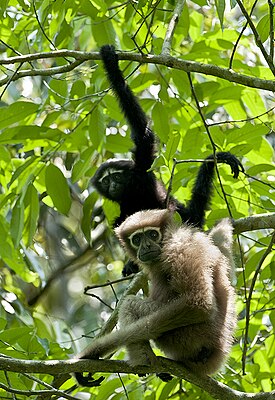Western white-browed gibbon
| Western white-browed gibbon | ||||||||||||
|---|---|---|---|---|---|---|---|---|---|---|---|---|

Male (back) and female (front) of the western white-browed gibbon ( H. hoolock ) |
||||||||||||
| Systematics | ||||||||||||
|
||||||||||||
| Scientific name | ||||||||||||
| Hoolock hoolock | ||||||||||||
| ( Harlan , 1834) |
The western white-browed gibbon or western hulock ( Hoolock hoolock ) is a tailless species of monkey found in northeast India south of Brahmaputra and Dibang , in northeast Bangladesh, and in Myanmar west of the Chindwin . The closely related eastern white-browed gibbon ( H. leuconedys ) lives east of the Chindwin .
features
Western white-brow gibbons can weigh 6 to 9 kg. The head-torso length is around 80 cm. Like the crested gibbons , the white- browed gibbons also show a pronounced sexual dimorphism . The males are black and have white eyebrows. However, in the western white-browed gibbon they have grown together or almost grown together, in the eastern white-browed gibbon they are more clearly separated. The chest is darker than the eastern white-browed gibbon. In adult males, the hair below the eyes and on the chin is white. Females have a yellowish coat that is slightly copper colored when they reach sexual maturity. The cheeks are dark brown. The dark face is surrounded by a ring of white hair.
Habitat and way of life
Western White brewing Gibbons live in tall trees in tropical rain forests and subtropical evergreen broadleaf forests, sometimes in bamboo stands or plantations of Chinese Lagerstroemia ( Lagerstroemia indica ) or Terminalia myriocarpa . They also occur in mountain forests up to altitudes of 2700 meters. To search for food or to get between fragmented forest stands from tree island to tree island they also go to the ground.
Like all gibbons, they feed primarily on ripe fruits, especially figs , as well as leaves, flowers, buds, shoots, petioles, insects, spiders and bird eggs. Fruits make up about 65% of their diet, animal food makes up about 5%. When fruits are scarce, they eat more leaves. In the Indian Borajan Wildlife Sanctuary, only 40% of their food consists of fruits and bamboo stalks are the most important substitute food. They spend the day mainly searching for food (25%) and eating (30%), resting (27%) and hiking through their territories (7%). Grooming and playing are less important.
Western white-browed gibbons mate in the rainy season from May to June. The young are born in the dry season from November to February. They are weaned at around two years of age. As a rule, three years pass between two births.
threat
The western white-browed gibbon is classified by the IUCN as "endangered" (highly endangered). In the past 40 years, the stock is said to have decreased by around 50%. The causes are hunting and the loss of suitable habitats.
More than 50% of the western white-browed gibbons in India live in isolated, small, non-viable sub-populations made up of one or two groups. About 2600 animals could still live there, 2000 of them in Assam . Since the animals don't like to get on the ground, they need contiguous forest areas in which they can shimmy from branch to branch (brachiation). If fodder and sleeping trees are felled, they lack the food base. Their habitat is cleared for construction timber, firewood and the paper industry. This creates erosions that tear away the fertile soil, and invasive, exotic plants can spread in place of native ones. Road construction and urbanization are also increasingly dividing forests into smaller areas. Unplanned, intensive tourism, natural gas production and even military exercises pose dangers for the gibbons and their habitat. Slash and burn operations are carried out to get room and space for agriculture such as tea plantations. Hunting as food or for traditional Asian medicine also decimates the population significantly.
The Namdapha National Park in Changlang district in Arunachal Pradesh has the largest, protected, contiguous forest in India and is a stronghold for the Western Hoolock Gibbon. It is also found in the Dibru-Saikhowa National Park and the Kaziranga National Park , as well as in other national parks and nature reserves in India and Bangladesh. In Bangladesh there were 200 to 280 copies in 2005/2006. There is no information about the stocks in western Myanmar. Since there are still thousands of square kilometers of unexplored rainforests there, the country could have the largest population of the western white-browed gibbon.
literature
- David J. Chivers, Martina V. Anandam, Colin P. Groves, Sanjay Molur, Benjamin M. Rawson, Matthew C. Richardson, Christian Roos & Danielle Whittaker: Family Hylobatidae (Gibbons). Pages 779-780 in Russell A. Mittermeier , Anthony B. Rylands & Don E. Wilson : Handbook of the Mammals of the World: - Volume 3. Primates. Lynx Editions, 2013 ISBN 978-8496553897
Individual evidence
- ↑ a b Hoolock hoolock in the endangered Red List species the IUCN 2008. Posted by: Brockelman, W., Molur, S. & Geissmann, T., 2008. Accessed March 10, 2016th